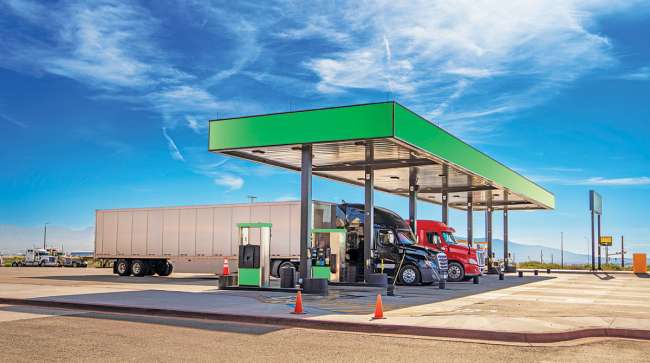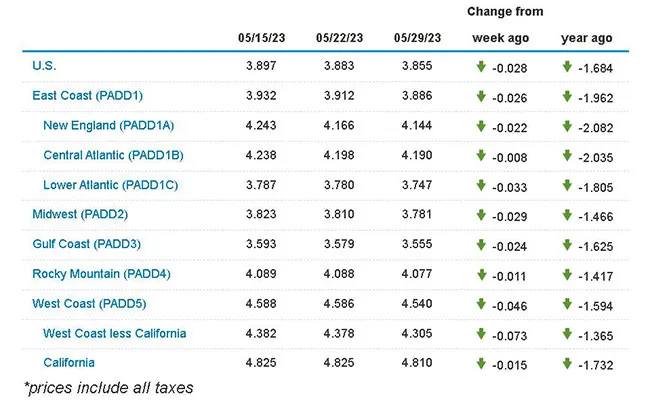Senior Reporter
Diesel Prices Slip 2.8¢ to $3.855

[Stay on top of transportation news: Get TTNews in your inbox.]
Diesel prices dropped 2.8 cents a gallon on average to $3.855, according to Energy Information Administration data May 29.
The cost for a gallon of trucking’s main fuel has declined six consecutive weeks since a 1.8-cent increase April 17. With this latest dip, diesel prices are down an average of 76.7 cents per gallon since reaching a 2023 high of $4.622 on Jan. 30.
Diesel prices now are down $1.684 a gallon from the same time in 2022.
EIA reported prices fell in all 10 regions in its weekly report, with the biggest decline — 7.3 cents — in the West Coast less California.
U.S. average retail prices for May 29, 2023:
Regular grade #gasoline: $3.57/gal
On-highway #diesel: $3.86/gal #gaspriceshttps://t.co/dsfxiPA8Wj — EIA (@EIAgov) May 30, 2023
Other regions saw diesel prices decline between eight-tenths of a cent in the Central Atlantic to 4.6 cents per gallon on the West Coast.
However, the price of unleaded regular gasoline increased 3.7 cents on average to $3.571 a gallon, $1.053 less year-over-year.
Oil analysts say the price decline of oil and the benchmark crude, West Texas Intermediate, is helping to drive down diesel prices and hold gas prices stable as the summer driving season begins.
U.S. On-Highway Diesel Fuel Prices

EIA.gov
WTI closed at $69.46 a barrel at the end of trading May 30, down from $114.61 a year ago. That is $8 a barrel lower than the high last summer, when that light sweet crude oil reached $122.11 a barrel July 8.
Wells Fargo’s John LaForge, a commodities specialist and head of real asset strategies, told Transport Topics the declining price of oil is pushing down diesel and gasoline, but the lower costs also are helping to reduce inflation.
“The direct impact, in your pocket where you don’t have to fill up and it isn’t so much, that energy cost is generally 3% to 4% of disposable income," LaForge said. “But energy costs are higher; it isn’t just heating your home or driving your car, it’s getting food to the market and that’s closer to 7% to 8% of your disposable income. Now you’re getting an extra 20% of that 7% or 8%, and that’s good money.”
Energy costs are higher; it isn't just heating your home or driving your car.
John LaForge, director of real asset strategies at Wells Fargo
Image
LaForge said domestic oil production still is close to 500,000 barrels per day below what it was at the beginning of the COVID-19 pandemic, when production reached 13 million. The lower oil prices mean energy companies aren’t making as much money, and they appear to be reluctant to explore for more oil.
“They are already hesitant to overproduce, and so what we have today is fewer wells being drilled. We have fewer rigs, and we are not producing the oil in the U.S. the way we were pre-COVID,” he said.
Still, EIA says domestic oil production is slowly, steadily increasing and may reach 12.8 million barrels per day next year.
“We forecast the U.S. benchmark West Texas Intermediate (WTI) crude oil price will average $77 per barrel in 2023 and $72 per barrel in 2024, down from $95 a barrel in 2022,” EIA said in its annual energy forecast. “Despite declining crude oil prices, we expect the WTI price will remain high enough to support crude oil production growth, especially in the Permian.”
The Permian Basin is the oil-rich area of West Texas and eastern New Mexico, which is estimated to still contain 50 billion barrels of recoverable crude and 300 trillion cubic feet of natural gas.

Flynn
Price Futures Group oil trader Phil Flynn said he is closely watching events on the international scene to see where oil prices go in the coming weeks and if global production levels remain stable or decline in an effort by OPEC+ nations to increase prices.
“If Saudi Arabia makes good on its threat to teach speculators a lesson last week, we could see a very quick spike up on the price of oil,” he said. “There is not a lot of room for error.”
On May 23, Saudi Arabia’s oil minister, Prince Abdulaziz bin Salman, said speculators should “watch out,” reiterating his warning that they could face pain ahead.
“I don’t have to show my cards, I’m not a poker player but I would just tell them, watch out,” he said at the Qatar Economic Forum.
OPEC+ will convene at a ministerial level June 4 to decide further production policy steps.
Want more news? Listen to today's daily briefing below or go here for more info:





